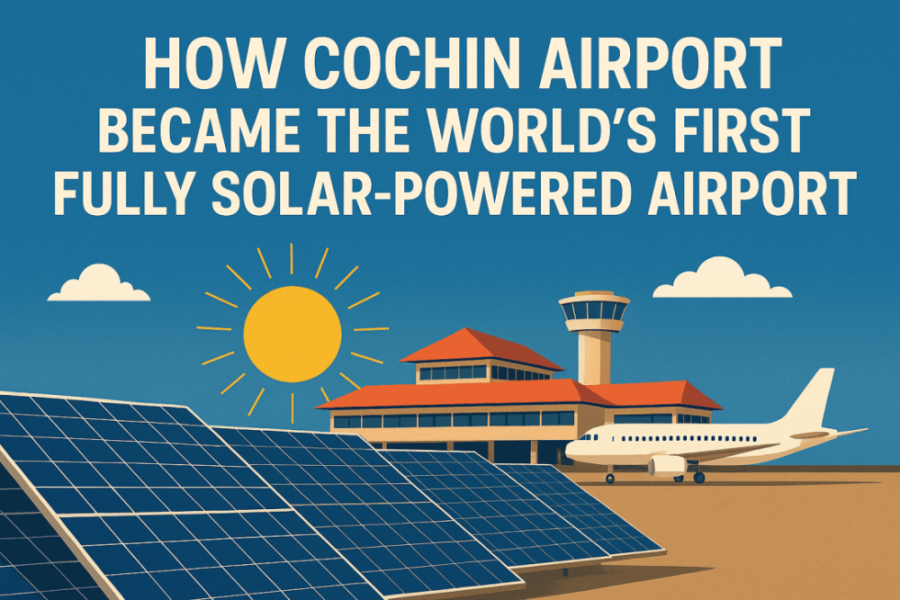Cochin International Airport: World’s First Fully Solar-Powered Airport
In a world increasingly focused on sustainable development, Cochin International Airport (CIAL) in Kerala, India, stands out as a shining example of green innovation. In August 2015, CIAL made global headlines by becoming the first airport in the world to run entirely on solar energy. This remarkable transformation didn’t happen overnight—it was the result of visionary leadership, strategic planning, and a strong commitment to environmental responsibility. Today, CIAL is not only a busy airport but also a model for airports and institutions worldwide. cial.aero
The Journey Toward Sustainability
Cochin Airport is one of India’s busiest airports, serving millions of passengers each year. Because of rising energy costs and environmental concerns in the early 2010s, airport authorities explored clean energy alternatives.
- Pilot Solar Plant: The journey began with a small 100 kWp rooftop solar plant as a pilot project. Its success in reducing electricity costs and carbon footprint encouraged the authorities to think bigger.
- 12 MWp Solar Plant (2015): By 2015, CIAL unveiled a massive 12 MWp solar power plant spread over 45 acres near the cargo complex. The plant featured over 46,000 solar panels capable of producing 50,000–60,000 units of electricity per day—enough to power the entire airport.
- Historic Milestone: On 18 August 2015, Cochin International Airport officially became the world’s first fully solar-powered airport, gaining recognition from international organizations including the United Nations Environment Programme (UNEP).
Key Features of CIAL’s Solar Power Project
- Zero Carbon Footprint: Solar energy reduces approximately 25,000 tonnes of CO₂ emissions annually, equivalent to planting 3 million trees.
- Grid-Connected System: The system connects to the state electricity grid. Surplus energy is transferred during the day, while power is drawn back at night.
- No Battery Backup: Instead of expensive and maintenance-heavy batteries, CIAL uses a net-metering system.
- Scalable and Replicable: The project serves as a model for other airports and public institutions worldwide.
Expansion and Innovation
CIAL continued to innovate after its initial success:
- Solar Carports: Covered parking areas equipped with solar panels.
- Canal-Top Solar Panels: Solar installations on nearby water canals, maximizing unused space.
- Additional Ground-Mounted Systems: Expanding capacity across airport premises.
- Terrain-Based Solar Installation (2022): At Payyannur, Kannur, CIAL installed solar panels on sloped terrain without flattening the land. This terrain-based approach increased land-use efficiency, allowing ~35% more panels and requiring just 2.75 acres per MW (vs 3.75 acres for flat land). (cial.aero)
As of 2025, CIAL’s total solar capacity has reached 50 MWp, with over 90,000 solar panels in operation. Beyond solar, CIAL has launched hydropower and biogas projects as part of its broader sustainability mission.
Global Recognition and Impact
CIAL’s achievements have gained worldwide recognition
- International Attention: CIAL has become a case study in renewable energy, attracting attention from sustainable infrastructure researchers worldwide.
- Champion of the Earth Award (2018): UNEP honored CIAL for its pioneering work.
- Green Airports Recognition 2025: Awarded by Airports Council International (ACI) Asia-Pacific & Middle East in the 6–15 million passengers-per-annum category. (cial.aero)
- Inspiring Other Indian Airports: Delhi, Hyderabad, and Bangalore have invested in solar energy, following CIAL’s example.
Cochin International Airport’s journey is not just a story of technological advancement but a bold step toward a greener future. By becoming the world’s first fully solar-powered airport, CIAL has proven that clean energy is not only possible but practical—even for large-scale infrastructure.
As climate change continues to be a global concern, Cochin Airport serves as a beacon of hope, showing the world that with vision and willpower, even the skies can be powered by the sun.





